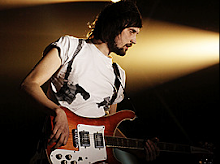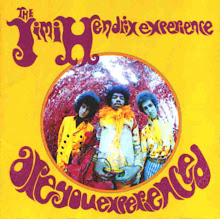 Ohio-based duo The Black Keys are well known for their concentrated hermetic approach to recording. Either they are seen hunkering down with rudimentary equipment in an unfinished basement, or commandeering the floor of a vacant local rubber factory. They do this to create terse but soulful rock that seems to have time-traveled into the pair's amps from some long-ago radio show. But guitarist-vocalist Dan Auerbach and drummer Patrick Carney now admit they were ready for a change of scene-as well as some company. So when they got the opportunity to work with Grammy Award-nominated producer-musician-provocateur Danger Mouse, a/k/a Brian Burton (Gnarls Barkley, Gorillaz, The Grey Album), they agreed, for the first time, to leave their familiar environs. They weren't quite willing to cross state lines yet, though.
Ohio-based duo The Black Keys are well known for their concentrated hermetic approach to recording. Either they are seen hunkering down with rudimentary equipment in an unfinished basement, or commandeering the floor of a vacant local rubber factory. They do this to create terse but soulful rock that seems to have time-traveled into the pair's amps from some long-ago radio show. But guitarist-vocalist Dan Auerbach and drummer Patrick Carney now admit they were ready for a change of scene-as well as some company. So when they got the opportunity to work with Grammy Award-nominated producer-musician-provocateur Danger Mouse, a/k/a Brian Burton (Gnarls Barkley, Gorillaz, The Grey Album), they agreed, for the first time, to leave their familiar environs. They weren't quite willing to cross state lines yet, though.The Black Keys had originally been approached by Danger Mouse to write songs for an album he was developing with Grammy Award-winning R&B legend Ike Turner, who, in recent years, had been recognized more for his contribution to the birth of rock & roll than for the time he'd spent in the tabloids. That project would never be completed, however, and the 76 year-old Turner passed away unexpectedly in December.
As the pair were composing and sending tracks out to Danger Mouse in Los Angeles earlier last year, ostensibly for Ike, they realized they were also instinctively laying the groundwork for a new album of their own. So when Patrick went to L.A. to visit his wife's family, he called up Danger Mouse to go out for drinks and, he says, "I asked him straight up if he wanted to produce our record. He said yeah, and we made a plan. Nothing was set in stone until about a week before we went in to record in August. I think Dan and I were intrigued to work with somebody as a producer because we both realized we couldn't teach ourselves anything more, and it was best to start learning from other people. When we were, like, 22, we didn't have the money to do this; by the time we were 24, maybe we thought we knew more than we actually did. Now, at 27, we maybe just realized we had stopped being broke, and stopped being dip-shits, and we could learn from other people who make records."
 "After doing four albums in the basement, we were ready to go somewhere else," Dan confesses, "but it couldn't just be anywhere. Brian suggested L.A., but we said no way. We still wanted to do it in Ohio. There's this guy named Paul Hamann, who has a studio outside Cleveland called Suma. I'd done a bunch of projects with him before, bands that I've recorded on the side. He's done some mastering and cut some vinyl for me. In fact, he's got one of the only studios in the world where they still cut their own vinyl. So we said we wanted to go there, and Brian said, 'Whatever you guys want.'"
"After doing four albums in the basement, we were ready to go somewhere else," Dan confesses, "but it couldn't just be anywhere. Brian suggested L.A., but we said no way. We still wanted to do it in Ohio. There's this guy named Paul Hamann, who has a studio outside Cleveland called Suma. I'd done a bunch of projects with him before, bands that I've recorded on the side. He's done some mastering and cut some vinyl for me. In fact, he's got one of the only studios in the world where they still cut their own vinyl. So we said we wanted to go there, and Brian said, 'Whatever you guys want.'"The legacy, the hand-built recording console, and the engineering skills of Hamann were undoubtedly attractive to The Black Keys, but perhaps it was the ambience of the place that really sealed the deal. As Patrick explains, with genuine affection, "The place is covered with dust, it smells like a moldy cabin, and it looks like a haunted house. It was fitting for our first time of going into a real studio-basically being in a haunted house that hasn't been updated since 1973." Dan continues, "A big part of the sound of this record is the studio and having somebody like Paul, who is an old pro, recording us and helping us get the right sound. Having him there meant that we were free to jump on any instruments we wanted to add stuff. If I wanted to play organ, I could jump on it and just record it; if I wanted to jump on the guitar, I could do it. Brian and Pat had a moog part they thought would be cool on a song, so they would just try it. That studio is a really special place."
Danger Mouse fit right in, too. Says Dan, "He came in as our collaborator. Brian does hip-hop, but he likes rock and roll, obscure 60s psychedelic stuff, and we listen to a lot of that too. So he was pretty easy to get along with. Brian has a real ear for melody and arrangement, and that was a big part of this record, his making suggestions about the arrangements."
Dan and Patrick were childhood buddies who grew up in the same Akron neighborhood and attended the same schools. But they didn't recognize their natural musical affinity until well into high school when they started jamming together with other aspiring musician friends, who they soon ditched. Early demos of The Black Keys featured a third member, who played a moog bass, but he didn't last long either, and they subsequently carried on as a duo. Says Dan, "Pat and I just click. We walk in to a groove quite easily. It's kind of hard to describe." Their minimalist approach to rock is similar to what the late-70s New York City duo Suicide's has been to electronic dance music: The Black Keys have been able to make something ferociously noisy, deceptively melodic, and surprisingly sincere out of the simplest tools and riffs. (Unlike Suicide, though, they're more congenial than confrontational with their audiences.)
 With Danger Mouse, The Black Keys didn't veer uncomfortably far from the elemental rock & roll territory they'd mined so effectively on previous albums like their 2006 Nonesuch debut, Magic Potion, or their Fat Possum discs, Rubber Factory (2004) and Thickfreakness (2003). But they were definitely in a mood to experiment on Attack and Release. Dan explains, "We'd never let it all go before like we did for this one, where anything was game." The new tracks have a spaciousness and clarity that accentuate the soulfulness in Dan's preternaturally weathered vocals and in arrangements that oscillate between melancholy and swagger. (On side-by-side, moody vs. head-banging versions of "Remember When," they do both.) There's a subtle range of extra instrumentation (organ, piano, synthesizer) and some very cool arrangements (like the ghostly choir that surfaces midway through "I Got Mine"). Guitarist Marc Ribot and Pat's uncle, multi-instrumentalist Ralph Carney-both veterans of Tom Waits' band-sat in for a few days of unfettered jamming. Jessica Lea Mayfield, an impressive eighteen-year-old bluegrass/country singer from Kent, Ohio, sings alongside Dan on the plaintive final cut, "Things Ain't Like They Used To Be." Dan and Patrick did finally head west for the mix. Recalls Patrick, "We started August 9; our last day was August 23. We went to L.A. to mix the record with Brian's engineer, Kennie Takahashi, who mixed the Gnarls record. He's a younger dude who knows his shit. He matched our rough mixes exactly-the EQ, the compression, everything. He just cleaned them up-or dirtied them up-from there.
With Danger Mouse, The Black Keys didn't veer uncomfortably far from the elemental rock & roll territory they'd mined so effectively on previous albums like their 2006 Nonesuch debut, Magic Potion, or their Fat Possum discs, Rubber Factory (2004) and Thickfreakness (2003). But they were definitely in a mood to experiment on Attack and Release. Dan explains, "We'd never let it all go before like we did for this one, where anything was game." The new tracks have a spaciousness and clarity that accentuate the soulfulness in Dan's preternaturally weathered vocals and in arrangements that oscillate between melancholy and swagger. (On side-by-side, moody vs. head-banging versions of "Remember When," they do both.) There's a subtle range of extra instrumentation (organ, piano, synthesizer) and some very cool arrangements (like the ghostly choir that surfaces midway through "I Got Mine"). Guitarist Marc Ribot and Pat's uncle, multi-instrumentalist Ralph Carney-both veterans of Tom Waits' band-sat in for a few days of unfettered jamming. Jessica Lea Mayfield, an impressive eighteen-year-old bluegrass/country singer from Kent, Ohio, sings alongside Dan on the plaintive final cut, "Things Ain't Like They Used To Be." Dan and Patrick did finally head west for the mix. Recalls Patrick, "We started August 9; our last day was August 23. We went to L.A. to mix the record with Brian's engineer, Kennie Takahashi, who mixed the Gnarls record. He's a younger dude who knows his shit. He matched our rough mixes exactly-the EQ, the compression, everything. He just cleaned them up-or dirtied them up-from there."I'm more pleased with the sound of this record than any we've ever made," Pat concludes. "Rather than mask things in, like, a low-fi fog, we can make things sound big and fucked up at the same time."






